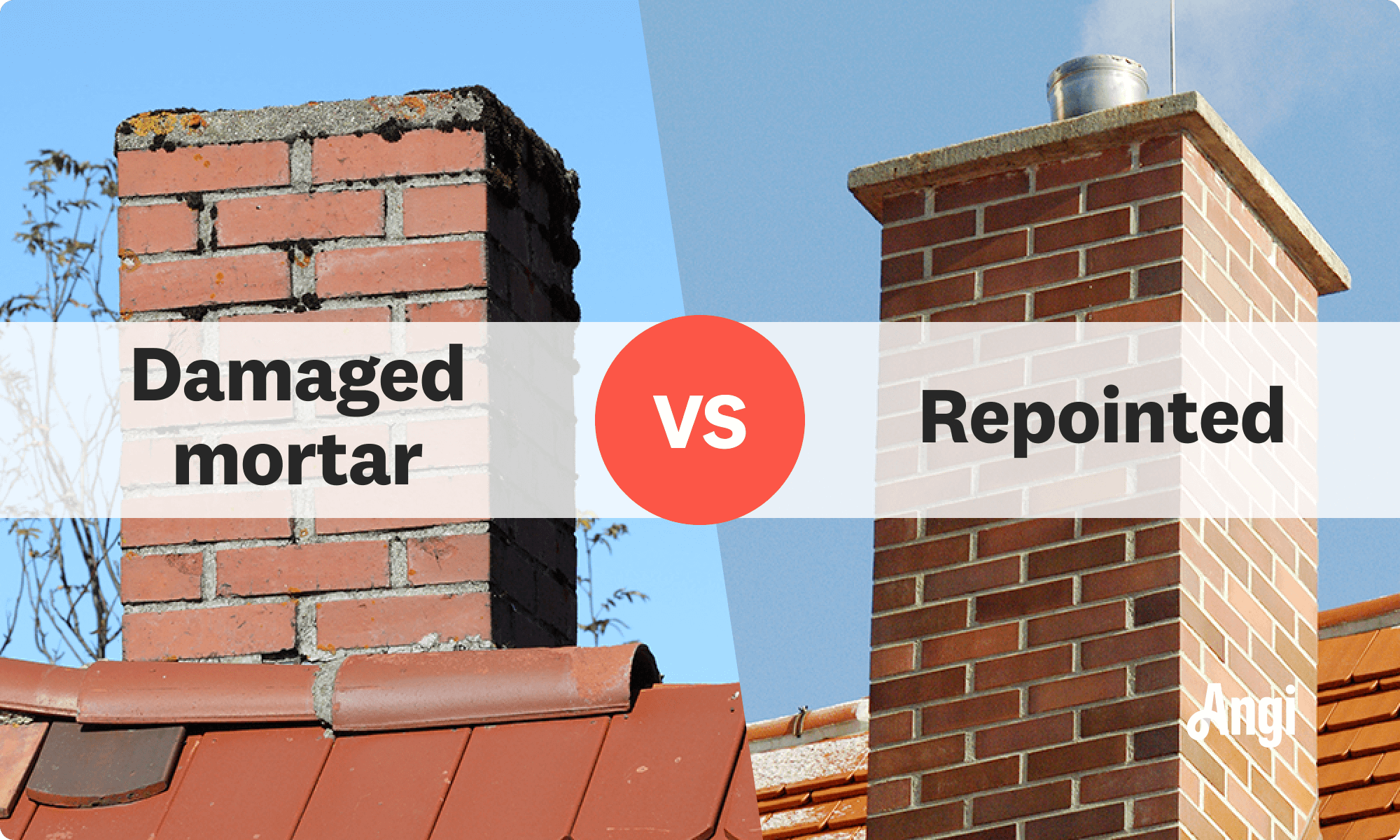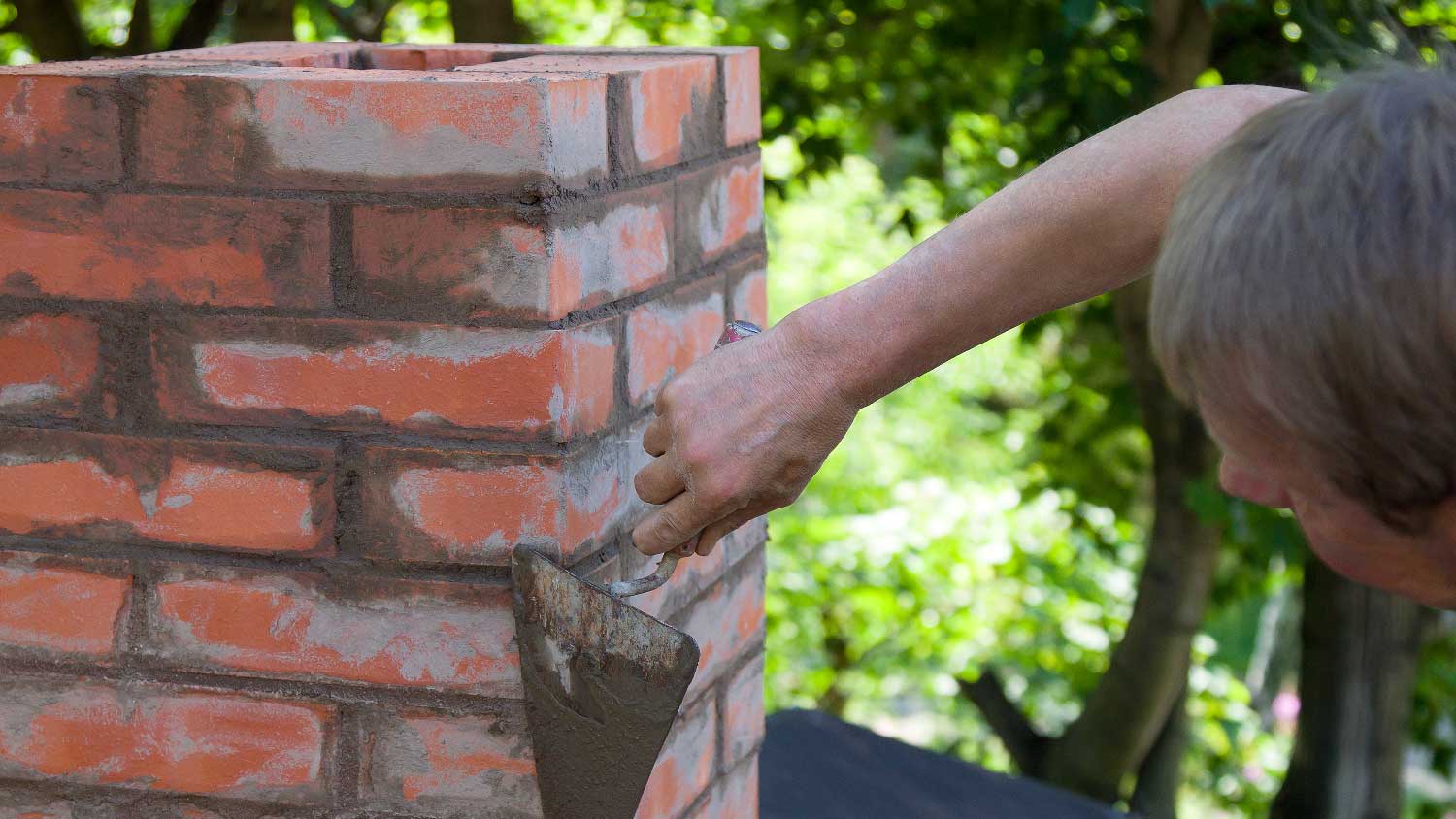
Your chimney inspection cost will vary based on the type of inspection, how accessible the chimney is, the chimney size, and the number of flues.
This process will keep a chimney safe and strong for years to come


Tuckpointing is the process of replacing old mortar between bricks and is necessary to keep brickwork structurally sound.
The term is commonly interchangeable with “repointing” and “pointing.”
Gaps, holes, or cracks in the mortar, loose bricks, and discoloration indicate it’s time for tuckpointing.
Tuckpointing a chimney usually requires a certified professional.
Your old brick chimney might seem like it’ll outlast everything, and while the bricks themselves can stand the test of time, their mortar—the paste in between—needs regular upkeep. That’s where tuckpointing comes in. Tuckpointing, or repointing, involves replacing old mortar with new mortar, and it’s especially important when it comes to structures like your chimney.

Tuckpointing is a masonry technique for repairing mortar (a paste made from cement and sand) between bricks and in the walls of a chimney. The process involves removing the old mortar from the mortar joint (the space between the bricks) and replacing it with new mortar.
Masonry is susceptible to deterioration and damage over time due to weather, moisture, and everyday wear and tear, and tuckpointing has been used for centuries to help keep brick structures stable and create a barrier to keep moisture out.
You might hear the terms “tuckpointing” and “repointing” used interchangeably. Repointing is the process of replacing old and damaged mortar with new mortar. Traditionally, tuckpointing is a type of repointing (or simply pointing) that uses two mortar colors. One color matches the brick and is applied first.
Then, a groove is carved into the fresh mortar, and a thin line of mortar is applied in a contrasting color. This gives the effect of very thin mortar joints, providing a sleek, clean look. Most of the time, however, especially in North America, “tuckpointing” is used to refer to the process of removing and replacing mortar.

Tuckpointing may be done for purely cosmetic reasons, but it’s mainly done to keep the wall or chimney structural sound. Mortar wears away over time from exposure to the elements, and if it’s not maintained, it can crumble and cause more damage to the entire structure. To keep your brickwork stable and know when it’s time for repointing, you should regularly inspect it for signs of damage. Here’s what to look out for:
Gaps in the mortar: Gaps between bricks indicate where the mortar has deteriorated and fallen away. This leaves the structure unstable, allowing moisture to get in and damaging the surrounding areas.
Cracking or crumbling: If you notice the mortar of your chimney cracking, crumbling, or otherwise coming apart, it’s time for a repair. Even tiny cracks can let moisture seep in, wreaking havoc on the interior structure.
Loose bricks: The main purpose of mortar is to hold bricks in place, so if you have bricks that are coming loose, the mortar isn’t doing its job. This can be a safety hazard if not dealt with quickly.
Dampness or discoloration: Water is a major cause of damage, so you want to look for signs of it seeping into weak spots in the brickwork. Dampness is an obvious sign of a leak somewhere, but also look out for subtler indicators, like discoloration. Bricks or mortar that appear darker may actually be wet. White, powdery stains (efflorescence) indicate where water has already seeped through and evaporated, leaving dissolved salt on the surface.
Tuckpointing might seem like a matter of aesthetics and curb appeal, but masonry work is quite complex. Some homeowners may be able to do tuckpointing projects on their own, especially for small, purely cosmetic fixes. But when dealing with the wall of a chimney, it’s important to ensure the work is done correctly so you and your family are safe. Also, doing any kind of work on the roof is dangerous.
Instead, it’s best to hire a qualified local chimney repair professional who can ensure quality repairs that will last for years. A pro can also get the job done quickly, so you don’t have to waste hours trying to tackle this project yourself.
The cost of tuckpointing will depend on the size of the brickwork needing repairs, the amount of damage to the masonry, and your location. In general, prices can range from $500 to $2,500. Tuckpointing a chimney can cost about $10 per square foot.
While bricks can last for hundreds of years, the mortar between them requires more upkeep. Still, tuckpointing can last 20 to 30 years, depending on the environment. If you’re living your forever home, you’ll likely only need it done once or twice, if at all. Of course, it’d be good to know when, if at all, the previous homeowners last repaired the chimney.
The best way to stay on top of tuckpointing and other chimney repairs is to schedule an annual chimney inspection. A professional can help you catch problems early and ensure the chimney’s structural integrity.
From average costs to expert advice, get all the answers you need to get your job done.

Your chimney inspection cost will vary based on the type of inspection, how accessible the chimney is, the chimney size, and the number of flues.

Notice leaks and corrosion around your chimney? You might need new flashing or some careful repairs. Here are some common chimney flashing repair costs.

Replacing your chimney increases home value and prevents hazardous structural damage. Learn how much to budget for chimney replacement costs.

If you want to be sure your chimney is working properly, you’ll need a professional inspection. So who does chimney inspections? We’ve got all the info.

Your chimney liner is a major piece of your fireplace. But what is it and what does it do? Learn the different types of flue liners and whether you need one.

Cracks in your chimney crown will grow over time and cause serious structural problems. Learn how to repair a chimney crown and prolong your chimney’s lifespan.